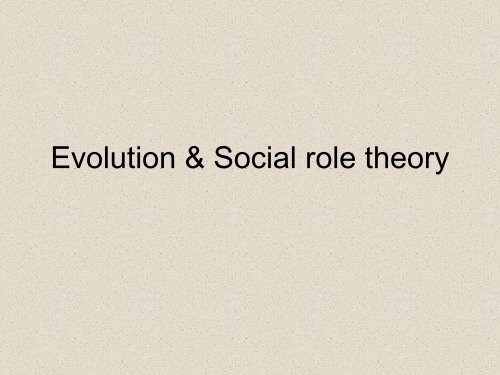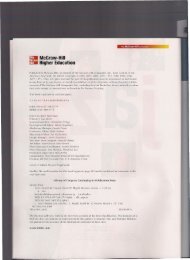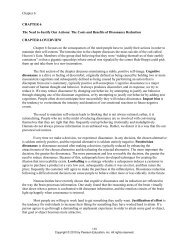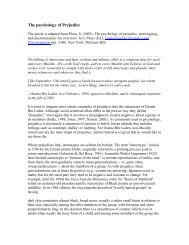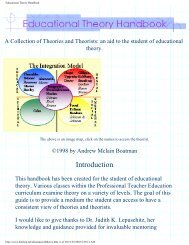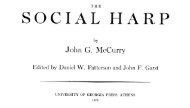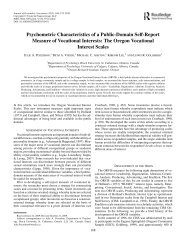Social role vs. evolutionary theory
Social role vs. evolutionary theory
Social role vs. evolutionary theory
You also want an ePaper? Increase the reach of your titles
YUMPU automatically turns print PDFs into web optimized ePapers that Google loves.
Evolution & <strong>Social</strong> <strong>role</strong> <strong>theory</strong>
<strong>Social</strong> Role Theory<br />
• Sex differences caused by<br />
– Each sex’s physical attributes and related<br />
behaviors—especially women’s childbearing and<br />
nursing of infants and men’s greater size, speed, and<br />
upper body strength and<br />
– Contextual factors represented by the social,<br />
economic, technological and ecological forces<br />
present in society (e.g., division of labor)<br />
• Also shaped by the formation of gender <strong>role</strong>s,<br />
expectancy confirmation, and self regulation<br />
(e.g., learning)
Evolutionary Perspective<br />
• Sex differences emerged from an asymmetry in<br />
the sexes’ parental investment and mating<br />
strategies<br />
– Women must invest more in offspring so they are<br />
choosier about potential mates than men<br />
– Women who cared for babies couldn’t get their own<br />
food so they needed men resources<br />
– Men competed with other men for sexual access to<br />
women and thus men evolved the dispositions that<br />
favor aggression, competition, and risk taking<br />
– To increase paternity certainty and gain fitness<br />
benefits from investing resources in their biological<br />
descendents, ancestral males developed a<br />
disposition to control women’s sexuality and to<br />
experience sexual jealously
Evolutionary Perspective<br />
• Men – to solve mating and reproductive<br />
problems men developed the masculine traits<br />
(competence, leadership skills, dominance, etc.)<br />
• Women – to solve mating and reproductive<br />
problems women developed feminine traits<br />
(nurturance, friendliness, submission)<br />
• Simple societies should most closely match the<br />
<strong>evolutionary</strong> adaptive environment
Evolution <strong>vs</strong>. <strong>Social</strong> Role<br />
Theory<br />
• According to <strong>evolutionary</strong> <strong>theory</strong>, in very simple societies<br />
we should see<br />
– Men controlling women (sexually and otherwise) and being<br />
jealous<br />
– Female preferences for men with resources<br />
– Men having greater power and aggressiveness<br />
• According to SRT, we should only see the above<br />
– In non-egalitarian complex societies<br />
– In complex societies where societal practices imbue child<br />
bearing with economic implications for men (e.g., warfare is<br />
necessary, economic gain requires travel and mobility)<br />
• That is, sex differences should be smaller or non-existent in very simple or<br />
egalitarian societies
Which <strong>theory</strong> has more<br />
support?
Wood and Eagly (2002)<br />
• Failed to find any universal or nearuniversal<br />
patterns across cultures in<br />
support of the sex-specific psychological<br />
tendencies that <strong>evolutionary</strong> psychologists<br />
assume evolved in relation to sexual<br />
selection pressures in ancestral<br />
environments
Sexual Control<br />
• In simple societies there is less control over women’s<br />
sexuality<br />
– The evidence suggests that women’s extramarital relations are<br />
socially sanctioned in a substantial percentage of non-industrial<br />
societies<br />
– Indices of patriarchy (patrilineal inheritance, patrilocal residence,<br />
importance of private property) predict male jealousy<br />
– Rape: In a sample of 80 societies, rape was more prevalent in<br />
societies with certain attributes—specifically, a greater incidence<br />
of warfare and interpersonal violence, a stronger ideology of male<br />
dominance, lesser female political and economic power<br />
– Reiss (1986) found that rape was correlated with macho attitudes<br />
and belief in female inferiority<br />
– These macho attitudes and ideologies were associated with<br />
indicators of patriarchy, such as the extent of agriculture, class<br />
stratification, the power of male kin groups, and greater<br />
segregation of men and women
SRT: Division of labor matters<br />
• In societies where women make economic<br />
contributions<br />
– Shlegel and Barry (1986) found that in<br />
societies in which women made substantial<br />
contributions to the food-based economy,<br />
evaluations of girls were more favorable,<br />
premarital sexual permissiveness was greater<br />
for girls, and the incidence of rape was lower
Mate Preferences<br />
• Men’s preference for young fertile women and women’s<br />
preference for wealthy men nearly disappears when<br />
equality/egalitarian attitudes are taken into account<br />
– Wood & Eagly reanalyzed the mate selection data of Buss’s<br />
(1989; showing gender diff. in mate preference) 37 cultures<br />
study by relating men’s and women’s reports of mate<br />
preferences with societal-level indicators of the extent of sexual<br />
equality in those countries<br />
– In patriarchal, traditional societies, women tended to prefer older<br />
mates and mates with resources, and men tended to prefer<br />
younger mates and mates with housekeeping and cooking skills.<br />
– The sex differences in mate preferences were less pronounced<br />
in more egalitarian societies
Evolutionary Perspective<br />
• Wood and Eagly’s research points to the<br />
possibility that <strong>evolutionary</strong> psychologists<br />
have reasoned from modern social<br />
conditions


